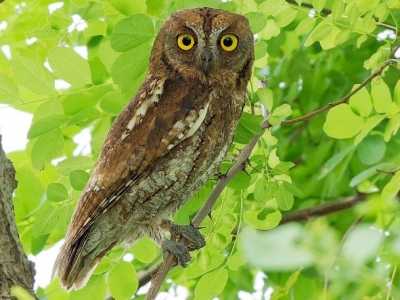
The oriental scops owl, or Otus sunia, is a small owl which belongs to the family Strigidae. Weighing about 95 grams and with a wingspan of 52 cm, these tiny owls have three types of plumages-gray-brown, reddish-brown or rufous and the more uncommon golden plumage. They may be distinguished from the collared owls by a white scapular stripe and well marked underparts. This owl has striking yellow eyes, whitish eye-brows and ear tufts that may not always be visible. Females are slightly larger in size and its call is a liquid sounding ‘tuk tok torok’.
It is found in deciduous and mixed forests, semi-open woodland, open evergreen forests and savannas. It may be found also in parks, orchards, gardens and temples. It is a nocturnal bird and will roost in a tree hole or against a tree trunk during the day. If disturbed this owl will ‘freeze’ with half opened eyes. It is an agile hunter and takes its prey off a perch or in mid-air. Its diet comprises insects, spiders, small birds and lizards.
The nest is usually a hole in a tree or a wall and the female will lay from 3 to 6 eggs which she incubates over 24-25 days.
This owl is found in Pakistan, India, Nepal, Bangladesh, Sri Lanka, Japan, Siberia, Manchuria, Taiwan, China and the Malay Peninsula. It is also found in the Andaman and Nicobar Islands. Since it has a very wide range, it is not threatened as of now and it is listed as ‘Least Concern’ in the IUCN Red List.
Picture Credit : Google




